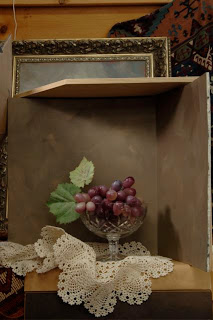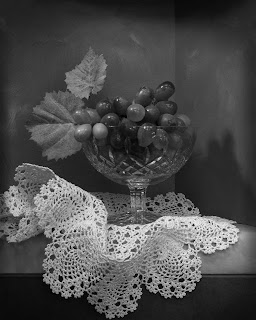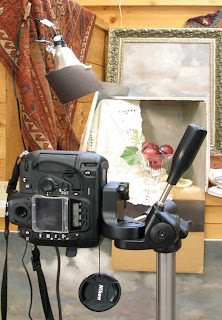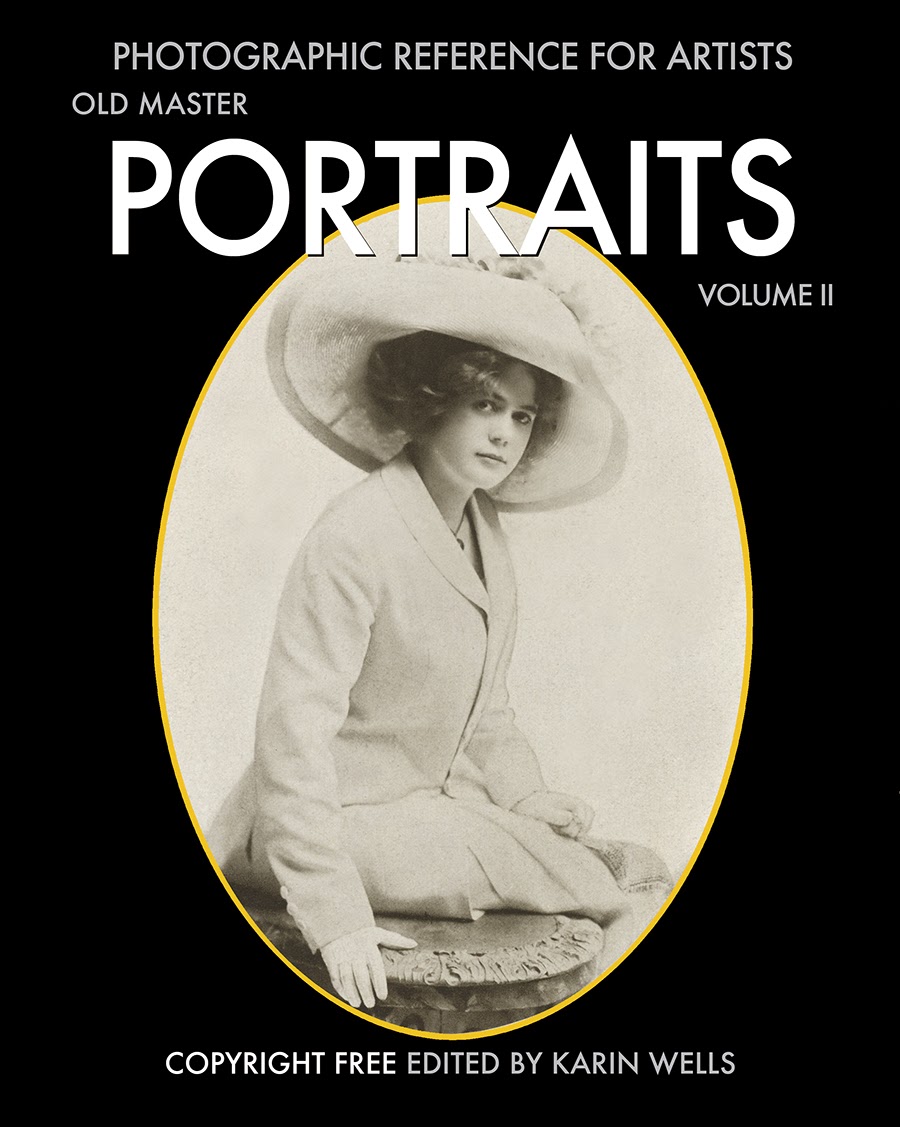Portrait of Grayson
How Ivory Black + White = Blue
My Old Masters Earth Palette




Making a Photo Reference for Still Life #2
When I shoot a still life or a portrait, I always have a miniature theatrical stage in the back of my mind. I am trying to to create a little one act play - all costume and atmospheric lighting - no script.
In order to save my back, I use a high shelf in my studio to set up my still life for a shoot. I use brown wrapping paper to simulate a “table top” and matte black paper to “fake” an edge beneath.

I like a box in order to “trap” the light. I use movable cardboard flaps to create shadows where I want them.
I anchor objects with masking tape, pins and even glue if necessary where it doesn’t show.
In my setup for a shoot I try to create a foreground – in this case it is where the drape spills over the table edge. A middle ground is the container of fruit. And a background – a piece of bent cardboard painted (aprox a 50% value) with either a neutral warm or cool color…and sometimes both.
Larger still lifes obviously require a larger setup.
Here are some rejects:

Besides the subject matter (bowl of grapes) being too dark overall, the white cloth at the bottom would become the focus. I could paint a pattern, embroidery, lace or somesuch to change this if necessary.

All is too bright - no atmosphere nor interesting shadow patterns here.

This is better and more interesting with off-white lace rather than a solid stark white cloth. However, I do not like the arrangement of the cloth. The leaves caught too much of the light and in the final painting would overwhelm the light on the grapes.

This is a screen shot of an iPhoto file on my Mac. You can see some of the volume of photos I took and rejected in order to get just one "workable" photo reference for a still life.
Shooting photographic reference for still life is so much easier than shooting the reference for a portrait. Portraits are more involved, complicated and can sometimes be stressful when time is limited. When this happens, I set up my entire shoot in advance and “test” the lighting so I don't have to fiddle around and waste time with too much technical stuff.
Making a Photo Reference for Still Life #1
I enjoy painting objects in ideal light and thus invite the viewer to see the astounding beauty in the simple things that we often overlook in our busy everyday lives.
I begin by choosing one particular theme (like “grapes & glass” in this example) – and then begin to photograph this in as many different ways I can think of with minor variations of materials, position, and lighting.
This is now much easier than it used to be because of the low cost of digital photography. Because I am better with a brush than a camera, I take a lot of “mistake” photos that I can toss away without regret.
I prefer to use photographic reference over “real life” because: 1) Fruit doesn’t last. 2) I often take a long time to apply paint in layers that need to dry first. 3) I cannot count on my feisty Studio Cat to leave my setup alone. 4) I don’t have a studio large enough to set up a long-term still life that cannot be touched or moved. 5) Sometimes I get busy with portraits and will wait weeks or months between still life painting sessions.
This is the reference photo I shot today:

This is the best reference shot of the lot (above) - unedited.

SAme photo but I have cropped and adjusted this photo in Photoshop with a small 8” x 10” still life painting in mind. I darkened the edges and darkened the light falling on the top leaf as it was distracting. In the final painting I would add some highlights here without increasing the overall value.
I have found that spending a LOT of time on the planning end will save endless frustrating hours with a paintbrush in my hand trying to correct fundamental mistakes. If a particular photo doesn’t “have it” and you cannot make it “right” – it will be hard to make a successful painting based on it.

The photo must look good in black and white. I am not entirely sure that the lacy cloth doesn’t overwhelm the grapes in its value. I need to think about how I wish to compensate for this. Sometimes I may need to make a charcoal or graphite drawing in order to figure out the correct value and composition.

I always take a peek at a photo in the Photoshop “Poster” filter. It will show me the massing of values and help me find the “center of light.”

I think that all good realistic paintings have solid abstractions that lie underneath the surface.
Shadows are very important elements of composition and this is a useful way to see them.
Handling Strong Diagonals in Composition
Sometimes I see the use of strong diagonals in a painting leading the eye directly into corners of the canvas. This makes for a very dull and static composition.
I have illustrated this concept below in the most simple way I can think of.

Achieving Traditional Lighting for Photographic Reference


"Winslow" Art Card

"Winslow" Giclée Art Card
With Winslow on patrol, my studio remains a blissfully mouse -free zone.
This is an original Giclée Art Print and is made from my original oil painting. Card, envelope and insert shown above. This is a signed Open Edition.
Giclées (zhee-clays) are exceptionally high resolution reproductions made on a specialty large format printer. This museum quality giclee is printed on a 100% cotton rag fine art paper. The finely ground pigments I have used are made from the same pigments used in the finest quality artist watercolors and oil paints.
Cello packaged, hand signed and assembled in an earth-toned 5" x 7" paper frame as shown with a lighter, warmer earth-toned envelope.
$10.00 each card
Plus $3.00 shipping with the USA (up to 6 cards in pkg)
PayPal & check friendly, to email me see "Contact"
"Wellscroft Sheep" Art Card
Sheep have been feeding and clothing man for more than 8,000 years. They are such a delightful part of our beautiful New Hampshire landscape and I love to draw and paint them.
This is an original Giclée Art Print and is made from my original oil painting. Card, envelope and insert shown above. This is a signed Open Edition.
Giclées (zhee-clays) are exceptionally high resolution reproductions made on a specialty large format printer. This museum quality giclee is printed on a 100% cotton rag fine art paper. The finely ground pigments I have used are made from the same pigments used in the finest quality artist watercolors and oil paints.
Cello packaged, hand signed and assembled in an earth-toned 5" x 7" paper frame as shown with a lighter, warmer earth-toned envelope.
$10.00 each card
Plus $3.00 shipping with the USA (up to 6 cards in pkg)
PayPal & check friendly, to email me see "Contact"
"Two Weeks Old" Art Card

"Two Weeks Old" Giclée Art Card
The powerful potential of any child to become an extraordinary human being is truly a miracle. I have painted a lot of small children but this little guy is my youngest portrait subject.
This is an original Giclée Art Print and is made from my original oil painting. Card, envelope and insert shown above. This is a signed Open Edition.
Giclées (zhee-clays) are exceptionally high resolution reproductions made on a specialty large format printer. This museum quality giclee is printed on a 100% cotton rag fine art paper. The finely ground pigments I have used are made from the same pigments used in the finest quality artist watercolors and oil paints.
Cello packaged, hand signed and assembled in an earth-toned 5" x 7" paper frame as shown with a lighter, warmer earth-toned envelope.
$10.00 each card
Plus $3.00 shipping with the USA (up to 6 cards in pkg)
PayPal & check friendly, to email me see "Contact"
"Summertime" Art Card
At the lake, this little swimmer tests the water with her toes before she jumps in.
This is an original Giclée Art Print and is made from my original oil painting. Card, envelope and insert shown above. This is a signed Open Edition.
Giclées (zhee-clays) are exceptionally high resolution reproductions made on a specialty large format printer. This museum quality giclee is printed on a 100% cotton rag fine art paper. The finely ground pigments I have used are made from the same pigments used in the finest quality artist watercolors and oil paints.
Cello packaged, hand signed and assembled in an earth-toned 5" x 7" paper frame as shown with a lighter, warmer earth-toned envelope.
$10.00 each card
Plus $3.00 shipping with the USA (up to 6 cards in pkg)
PayPal & check friendly, to email me see "Contact"
"Rag Doll" Art Card

"Rag Doll" Giclée Art Card
This was a studio prop that sat on my windowsill and watched me paint. My rag doll eventually found a good home with a charming little visitor who fell in love with her.
This is an original Giclée Art Print and is made from my original oil painting. Card, envelope and insert shown above. This is a signed Open Edition.
Giclées (zhee-clays) are exceptionally high resolution reproductions made on a specialty large format printer. This museum quality giclee is printed on a 100% cotton rag fine art paper. The finely ground pigments I have used are made from the same pigments used in the finest quality artist watercolors and oil paints.
Cello packaged, hand signed and assembled in an earth-toned 5" x 7" paper frame as shown with a lighter, warmer earth-toned envelope.
$10.00 each card
Plus $3.00 shipping with the USA (up to 6 cards in pkg)
PayPal & check friendly, to email me see "Contact"
"Portrait of Fluffy" Art Card

"Portrait of Fluffy" Giclée Art Card
Fluffy is an unusually beautiful and elegant feral cat and it is always a challenge to paint or draw her. She can sometimes be bribed with food - but not nearly as often as I would like.
This is an original Giclée Art Print and is made from my original oil painting. Card, envelope and insert shown above. This is a signed Open Edition.
Giclées (zhee-clays) are exceptionally high resolution reproductions made on a specialty large format printer. This museum quality giclee is printed on a 100% cotton rag fine art paper. The finely ground pigments I have used are made from the same pigments used in the finest quality artist watercolors and oil paints.
Cello packaged, hand signed and assembled in an earth-toned 5" x 7" paper frame as shown with a lighter, warmer earth-toned envelope.
$10.00 each card
Plus $3.00 shipping with the USA (up to 6 cards in pkg)
PayPal & check friendly, to email me see "Contact"
"Wish List" Art Card
I cannot think of a better present for all the children on earth than the gift of "Peace On Earth." I used this design as my Christmas Card last year.
This is an original Giclée Art Print and is made from my original oil painting. Card, envelope and insert shown above. This is a signed Open Edition.
Giclées (zhee-clays) are exceptionally high resolution reproductions made on a specialty large format printer. This museum quality giclee is printed on a 100% cotton rag fine art paper. The finely ground pigments I have used are made from the same pigments used in the finest quality artist watercolors and oil paints.
Cello packaged, hand signed and assembled in an earth-toned 5" x 7" paper frame as shown with a lighter, warmer earth-toned envelope.
$10.00 each card
Plus $3.00 shipping with the USA (up to 6 cards in pkg)
PayPal & check friendly, to email me see "Contact"
"Pears Still Life" Art Card

"Pears Still Life" Giclée Art Card
I really enjoy portraying the simple beauty of ordinary objects in my work. Sometimes I think I should call my kind of painting Classical Idealism.
This is an original Giclée Art Print and is made from my original oil painting. Card, envelope and insert shown above. This is a signed Open Edition.
Giclées (zhee-clays) are exceptionally high resolution reproductions made on a specialty large format printer. This museum quality giclee is printed on a 100% cotton rag fine art paper. The finely ground pigments I have used are made from the same pigments used in the finest quality artist watercolors and oil paints.
Cello packaged, hand signed and assembled in an earth-toned 5" x 7" paper frame as shown with a lighter, warmer earth-toned envelope.
$10.00 each card
Plus $3.00 shipping with the USA (up to 6 cards in pkg)
PayPal & check friendly, to email me see "Contact"
"My Best Friend" Art Card

"My Best Friend" Giclée Art Card
My best friend Sarge (named after John Singer Sargent) likes to sleep on the run underneath my easel while I paint. He never criticizes my work. This painting was originally done for my students as a demonstration of the underpainting technique of the Old Masters.
This is an original Giclée Art Print and is made from my original oil painting. Card, envelope and insert shown above. This is a signed Open Edition.
Giclées (zhee-clays) are exceptionally high resolution reproductions made on a specialty large format printer. This museum quality giclee is printed on a 100% cotton rag fine art paper. The finely ground pigments I have used are made from the same pigments used in the finest quality artist watercolors and oil paints.
Cello packaged, hand signed and assembled in an earth-toned 5" x 7" paper frame as shown with a lighter, warmer earth-toned envelope.
$10.00 each card
Plus $3.00 shipping with the USA (up to 6 cards in pkg)
PayPal & check friendly, to email me see "Contact"
















